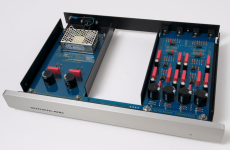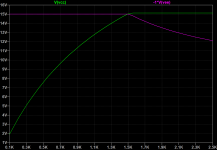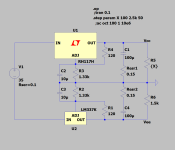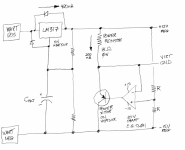I have some that I've used for many different projects, but nothing with high gain like a phono pre. Never had an issue with noise though. The ones I have clean up well with a little filtering on the input/outputs.I have used the Murata DC-DC +/- 15VDC converters. They are a bit noisy for this application.
If you want to give one a try, let know. I still have a few somewhere.
https://www.mouser.com/ProductDetai...BWR-15-330-D12A-C?qs=b13bmSh8y6xAobPTcN9SYQ==
The Pearl 3 needs +/-15V power. Hmmm, perhaps there is a wall wart solution which would save space and money. An old HP Printer of mine bit the dust and it has a +32V/5A supply. Maybe a filter and rail splitter. Here's the problem:
jackinnj,
Are you planning to use the LM7815 and LM7915 on the P3 PCB's ?
Thanks DT
Are you planning to use the LM7815 and LM7915 on the P3 PCB's ?
More regulators require more overhead than the SMPS can provide. Not that it matters a whole lot, but the double LM317 arrangement will also be less noisy (though the cap multipliers certainly do the trick.)
I'm just cheap and want to sever the umbilicus!
I've been using a 24VAC wall wart to power my pre with great success. The AC wall wart (of your choice) feeds an adjustable 317/337 based regulator. This can also be used with a split tranny. The values can be easily changed to get any +/- that you'd want. I'll send you the gerbers if you want them. Note that the recitifer stage ground ties back into main ground at the source point to minimize noise.How about an AC wall-wart and a simple linear power supply like Rod Elliott's ESP-05 Mini? AC wall warts are not common but I have picked up a couple (16V AC) at car boot sales for a song. Creative Labs used to use them for a PC speaker system.
Attachments
Last edited:
@audiosteve: I've tried that and it oscillated. This can happen if the currents drawn by each rail are unequal.
Didn't Sutherland also use a bank of batteries in one of their preamps.Sutherland did it.
_
Seriously? What oscillated? I've never had that problem. That makes no sense. I doubt the issue was with the topology. Please eelaborate if you can. Thanks.@audiosteve: I've tried that and it oscillated. This can happen if the currents drawn by each rail are unequal.
Something like this, just use your favorite LDO
regulator instead of the 7815, and either replace
the TLV431 with a TLV431H or a TL431 and recalculate
the resistors.
From the bar.
regulator instead of the 7815, and either replace
the TLV431 with a TLV431H or a TL431 and recalculate
the resistors.
From the bar.
Attachments
Last edited:
HI Jan,Be my guest! 😎
Jan
Yes, I expected you might be too busy, not interested enough or both but expectations are often wrong so I had to ask at least. Thanks for taking the time to reply.
This is why you can't use LM317/LM337 as a rail splitter -- as the load on one changes, the voltage on the other moves in the opposite direction. It's a simple simulation changing the value of a resistor to mimic current drawn:
The LM317 needs a minimum load of 5mA to remain stable. This results from the change in transconductance of the pass transistor with current,
The LM317 needs a minimum load of 5mA to remain stable. This results from the change in transconductance of the pass transistor with current,
Attachments
RJM1 - What was that .rar file you posted? VLC tries to open it but can't. Not sure what to use. Thanks
You are right...works only when both source current...Doesn't the synthesized ground have to source and sink current? Each channel's 4xJFET first stage squirts approximately 12 mA into the ground network (schematic in post #1 of the Pearl 3 thread). Are you confident the LM317 called "U2" is able to sink 24 mA?
You may wish to pursue the idea of shunt regulators rather than series; shunt regulators can source current and also sink current (within limits).
RAR file was deleted as it contained the wrong .jpg.
This was not updated because the correct .jpg did
not cotain any useful information.
This was not updated because the correct .jpg did
not cotain any useful information.
One approach could be to use a DC/DC converter to take a single DC voltage and turn it into a ±15 V supply. For example the Mean Well DPBW03F-15 or DKM10E-15. I use the DKM10E-15 in my HPA-10 and it's hard to argue against its performance.
I have noticed, though, that some AC/DC switchers inject quite a bit of mains hum into the circuit. You may have to try a few to find one that works well.
Tom
I have noticed, though, that some AC/DC switchers inject quite a bit of mains hum into the circuit. You may have to try a few to find one that works well.
Except you can't buy those anymore. At least not in North America. I think they were phased out due to their no-load losses. Many years ago I measured the power consumption by various wall warts. Many of them used a few watt even with no load connected. That won't meet modern energy efficiency standards, so they're practically banned for all but industrial uses. I know because I really wanted to use a classic wall wart with the HPA-10. I asked the main distributors (Mouser, Digikey, Future, et al.) and none of them could deliver a simple wall wart. The ones that remain show as "for industrial use only" on the distributors' websites.For reasonably low current, there's the idea of a single 15-20V AC secondary winding (from an old-fashioned 50-60Hz walwart) powering two half-wave supplies.
OTOH, those switching spikes are pretty easy to filter out. Also, switchers nowadays tend to feature spread-spectrum clocking and all sorts of neat tricks to reduce noise (and EMI).Switching supplies for audio seem worriesome with the noise generated by fast switching and such.
Tom
.... or during startup and power-down. Yeah. I'm not a fan either.Including the possibility of shooting a third of an ampere through the windings of a moving coil cartridge, if the rail splitter circuit fails.
Tom
- Home
- Amplifiers
- Power Supplies
- Can you wall-wart power an MC Phono pre-preamplifier (like Pearl 3)



